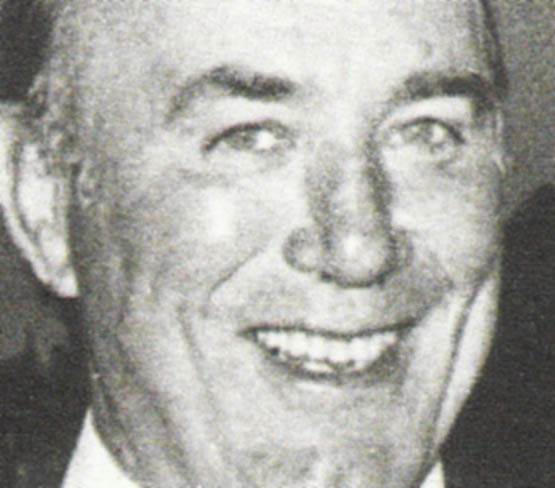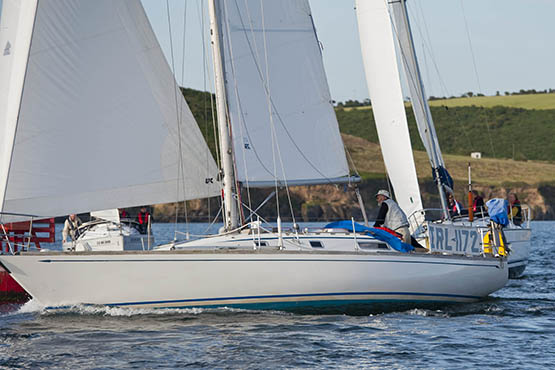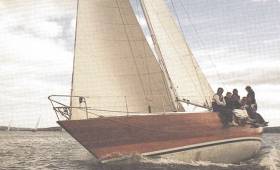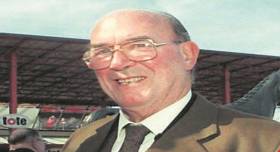Displaying items by tag: Archie O'Leary
Archie O'Leary 1929–2016
In a well-lived life in Cork in which he was exuberantly involved in several sports and long active in a pioneering role in business, he was known to everyone as Archie O’Leary. Yet properly speaking he was Arthur O’Leary, sharing his name with the historic and heroic figure of Art O’Leary (1746-1773). But this modern Arthur O’Leary, who has now gone from among us at the age of 86, was of more than enough significance to merit his own distinctive name.
It was as Archie O’Leary that he played rugby for Ireland, rising through the ranks of Cork Con (where he was Captain) and Munster, to win three caps in the national side in 1952. It was Mr & Mrs Archie O’Leary who became well known in racing circles, their most famous and successful horse being Florida Pearl. And it was as Archie O’Leary that he served as Admiral of the Royal Cork Yacht Club from 1977 to 1980, crowning a very long sailing career which was to continue until the1990s, when he changed his perspective afloat by moving into a Nelson 42 powercruiser, the kind of motoryacht which was designed with senior sailing people in mind.
His energies afloat and on the sports field were matched by his energy in business – in 1961 he founded the O’Leary Insurance Group which today, under the Chairmanship of his son Anthony, has expanded to become an all-Ireland force in the industry. The strength of family values within the O’Leary clan is also reflected by the fact that Anthony took on the demanding role of Admiral RCYC at a young age in 2000, just twenty years after his father had headed the club. And Anthony has of course carved his own distinctive and successful career in sailing (he’s currently the Irish Champion Helmsman), while his own sons in turn – Archie’s grandsons – include Olympic sailor Peter, Student World Sailing Champion Nicholas, and Irish Student Champion Robert.

Archie O’Leary, Admiral RCYC 1977 to 1980
Today, we honour the memory of the Patriarch of this remarkable family of sailing high achievers, for Archie O’Leary was an extremely successful owner-skipper in his own right. Like many of Cork sailing’s racing aristocracy, his first proper taste of the sport was with the National 18s. But by the early 1970s he found that offshore racers best suited his tastes, and he campaigned an S&S 34 for a couple of seasons, starting to build up friendships at home and abroad which well withstood the test of time.
By late 1973, the new blossoming of Cork sailing was becoming very apparent, and while the most active campaigner Hugh Coveney went for the peak challenge of the International One Ton Cup with the state-of-the-art one-off Ron Holland-designed, George & Killian Bushe-built 36ft Golden Apple, Archie O’Leary took a different tack by commissioning a new though standard Carter 37 from the board of Dick Carter. Carter had burst upon the scene in 1965 when his innovative 34-footer Rabbit won the Fastnet Race overall, and had subsequently won the One Ton Worlds with the Dutch-American owned Tina in 1966, Optimist of Germany in 1967 and 1968, and the Italian entry Ydra in 1973.
From today’s perspective, it is difficult to grasp the scale and enthusiasm of the One Ton Worlds at Torquay in 1974. Here were more than forty red hot boats around the 36ft mark from all over the world, and all competing absolutely level, sailed in many instances by Olympic-standard crews. Many were expensive purpose-built one-offs, yet there was also a small but significant group of production boats, tuned to the One Ton rating, which were expected to be little more than cannon fodder in a field of this standard.

The first Irish Mist of 1974 was a standard Carter 37, and she was clear winner of the Production Boat prize at the One Ton Worlds that year
But Archie O’Leary’s standard Carter 37 Irish Mist was definitely not cannon fodder. With the young Anthony O’Leary now very much an active member of his father’s crew, Irish Mist was at the races, and then some. She won the Production Boat prize by a very clear margin, and placed tenth overall with an entire host of extremely hot one-offs astern of her.
As his sailing career progressed and developed, Archie O’Leary was to win many other major prizes, both offshore and on the championship circuit. But in later life there was no trophy he cherished more than the fine cup he’d been given in perpetuity for that Production Boat win at Torquay, for he reckoned that was purer sport than the competition he was soon to experience at the very sharpest end of international sailing.
Yet the pace was now inevitably set, and for 1975 the O’Learys commissioned a one-off Ron Holland Two Tonner, the 40ft Irish Mist II, built at Rochestown by George and Killian Bushe. This superboat really did have all the bells and whistles, complete with a Bergstrom Ridder hyper-light mast. She lived up to all her billings, winning the 1975 RORC Channel Race as a member of the Irish Admirals Cup team, in addition to many other podium places, while the following year she was overall winner of the RORC Irish Sea Race and was also top boat in the biggest regatta in Ireland that year, ISORA Week 1976 at Cork.
In the mid-1970s, the Irish Sea Offshore Racing Association was at its most numerous, and if they brought their Race Week to some venue, it guaranteed big turnouts. But ISORA had at least half a dozen and more locations to choose between – they mightn’t be back for another ten years. However, by this stage Archie O’Leary was rising through the officer ranks in the Royal Cork, and by the time he became Admiral in 1977, he’d realized that a more regular regatta week was essential for the good health of Crosshaven, and he’d plans in shape for what would become Cork Week, run on a biennial basis with the first one in 1978.
To make it all happen, he drew on firm friendships made through his years of active campaigning on the RORC and Celtic Sea programmes, and thus people like Chris Dunning from the Solent and Rob Davies from South Wales could be relied on to beat the drum for their friend Archie and his regatta in Cork, and this was to be the start of something big.
But in the best Cork traditions, while working busily in the administration of the rapidly-expanding Royal Cork YC, Admiral O’Leary continued as a very active sailor, moving on from the timber-built Irish Mist II to the glassfibre Swan 39 Irish Mist III, the production version of the fabulously successful Ron Holland-designed Regardless, and from there he went on to a Lightwave 395.
Although he was best noted for his national and international achievements, Archie O’Leary was never happier than when involved in the notably high standard of club racing against old friends at Crosshaven, when the finest traditions of the world’s oldest yacht club are given a contemporary twist.
In fact for decades – with his actively sailing family spreading onto three generations – Archie O’Leary was the very expression of the Cork sailing spirit. And even when he’d reduced the pace by changing to the Nelson powercruiser, his taste for a spot of sport afloat was undiminished. My most abiding recent memory of Archie O’Leary was of a time one Spring some years ago when his beloved Cork Constitution Rugby Club (of which he was President in 1973-74) had won through to the Irish club final, to be played at Lansdowne Road in Dublin. Archie noted that the weather pattern was settling down nicely, so he suggested to his regular shipmates that they should go in style to Dublin with the powercruiser, and use her as a houseboat for the weekend of the match.
Then as the weekend approached, a wondrous and unseasonal calm settled over all Ireland. So what did the O’Leary crew do? They came to Dublin from the north. Bound for the rugby match, they left Cork heading west, streaked up the Atlantic seaboard, roared along the north coast, zoomed down the Irish Sea to take in the match, and then went on home by sea as though this was all part of a normal weekend away for rugby fans. That was how Archie O’Leary approached life. Our heartfelt condolences go to his family and very many friends.
WMN
Archie O'Leary RIP
Royal Cork Yacht Club is mourning the loss of senior member Archie O'Leary who died at the weekend. Mr. O'Leary (86) was the founder of O’Leary Insurance Group in 1961, owner of racehorse Florida Pearl, and a former Ireland rugby international. Mr O’Leary, who twice skippered a boat in the Irish Admiral’s Cup team in the 1970s lived in Cork Harbour at Currabinny and was a keen yachtsman. He and his family have a major involvement in Munster sailing, his son Anthony is a double winning Captain of the Commodore's Cup and his grandson Peter is a double Olympian from the Beijing and London Olympic Games.
He passed away peacefully on Saturday in Marymount Hospice after a battle with cancer. He is survived by his wife Violet and two children Frances and Anthony.
Please see our full appreciation here
His removal takes place at 7.30pm tonight from Temple Hill Funeral Home, Boreenmanna Rd to St Brigid’s Church, Crosshaven. Funeral arrangements are here






























































